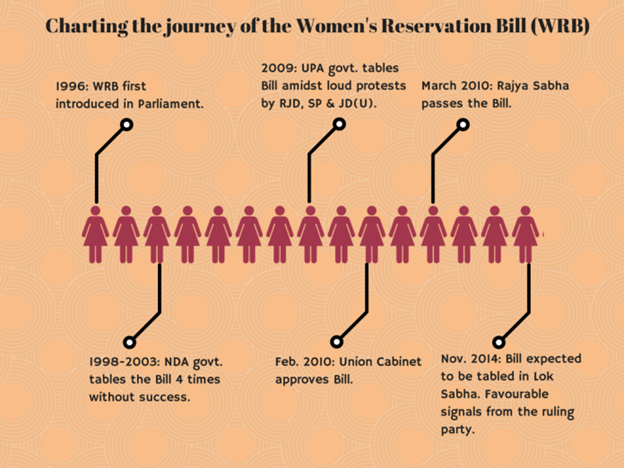Women’s quota, panchayats to Parliament
Relevance
GS Paper 2, Parliament, Issues Related to Women, Executive, State Legislature, Government Policies & Interventions, Indian Constitution, Gender.
Tags:#Women’s quota, #Women’s reservation, #Women in panchayat
Why in the news?
- The landmark Women’s Reservation Bill — now the Constitution (106th Amendment) Act — that reserves one-third of the total seats in the Lok Sabha and State Legislative Assemblies for women, contingent on the conduct of delimitation and census, received presidential assent recently.
- As the first law passed in the new Parliament building during a special session, it portends a new chapter in India’s democratic journey. It comes on the 30th anniversary of the constitutional reforms of 1992 (73rd Amendment Act) that reserved one-third of seats in panchayats and municipalities for women.
Lessons from past reforms
- Parliament, 30 years ago, enacted the 73rd and 74th Constitutional Amendments that sought to make panchayats and municipalities “institutions of self-government”.
It mandated the following
- A minimum of one-third of seats and office of chairpersons in panchayats and municipalities to be reserved for women.
- Reservation for Scheduled Castes (SCs) and Schedule Tribes (STs) based on their percentage population and enabled States to reserve seats for Backward Classes (OBCs).
- This has created a system with over 3 million elected panchayat representatives, out of which almost half are women. The expansion and diversification of the representative base of Indian democracy is the most successful element of these constitutional reforms.
- While the Union government’s 2009 constitutional amendment to increase women’s reservation in local governments from 33% to 50% failed, many States have enacted laws that reserve 50% seats for women and also instituted reservations of seats for Other Backward Classes (OBCs).
- Hence, presently in panchayats and municipalities, there is, at one level, vertical reservation of seats for SCs, STs, and OBCs and a horizontal category of reservation for women that applies across all categories — general, SC, ST, and OBC.
Intersectional disadvantages
- Such a mix of vertical and horizontal reservations recognizes the aggravated disadvantage people face due to their location in the intersection of their caste and gender identities.
- The present women’s reservation law, as well as its previous avatar passed by the Rajya Sabha in 2008, adopts a similar model of intersectional reservation for women. However, unlike the case of the 73rd and 74th amendments, the present law does not enable reservation for OBC women.
Impact of reservations
Beyond representation, has women’s reservation in local governments yielded substantive benefits?
- A 2004 paper by Esther Duflo and Raghavendra Chattopadhyay on panchayats in West Bengal and Rajasthan found that women leaders invest more in public goods and ensure increased women’s participation in panchayat meetings.
- Another study in 2011 across 11 States by Ms. Duflo and others reaffirmed the finding that women-led panchayats made higher investments in public services like drinking water, education, and roads.
Counterview
- However, a 2010 paper by Pranab Bardhan et al found that women’s reservations worsened the targeting of welfare programs for SC/ST households and provided no improvement for female-headed households.
- A 2020 paper by Alexander Lee and Varun Ramachandra examining reservations in Delhi found that constituencies reserved for women are less likely to elect OBC women and more likely to elect upper-caste women.
Uncertain future
- Evidently, the impact of women’s reservation is not straightforward. The design of women’s reservations in Parliament and State Assemblies should have ideally been informed by its 30-year experience in panchayats and municipalities. Since the role that women play in local governments is different from their role in Parliament, the impact of reservation may play out differently.
- However, something as vital as a constitutional amendment for women’s reservation should have been introduced after widespread discussion and analysis of its experience, instead of being introduced surreptitiously through a “supplementary list” in a hastily organized Parliament session.
Delimitation and census
- Unlike the 2008 version, the present women’s reservation law has tied its implementation with the conduct of delimitation and census, neither of which have a definite date. The constitutional freeze for delimitation, whichdecision-making has been in place since 1976, will end in 2026.
- If the reallocation of seats between States is purely based on population, the southern States’ share in the Parliament will drastically reduce. So, the next delimitation exercise is likely to open up the fault lines of India’s delicate federal relations.
How can Women’s Representation be Effectively put into practice?
Strengthen Independent Decision Making
Establish an independent monitoring system or committees that explicitly prohibits family members from influencing the decision making process of women representatives. It can be implemented by reducing the influence of the patriarchal mindset.
Increasing Awareness and Education
Creating awareness among women about their rights and the importance of their participation in politics is essential. Educational programs and awareness campaigns can help to increase women’s political participation.
Addressing Gender-based Violence and Harassment
Gender-based violence and harassment are major obstacles to women’s participation in politics. Addressing these issues through policy and legal measures can create a safer and more supportive environment for women in politics.
Reforms in the Electoral Process
Reforms such as introducing proportional representation and preferential voting systems can help to increase women’s representation in politics by ensuring that more women get elected.
Conclusion
- Hence, coupling women’s reservations with a politically fraught delimitation exercise makes its implementation contentious. Hopefully, the near unanimity in the passing of the Bill signals that there will be some consensus on implementing women’s reservations shortly.
Source: The Hindu
Mains Question
Examine the reasons for under-representation of women in the Indian Political System. How far the Women Representation Bill, of 2023 will close the gender gap in Indian politics?




